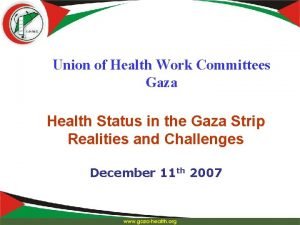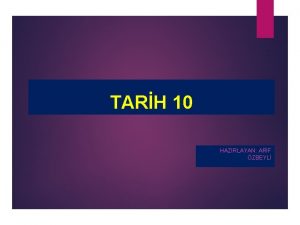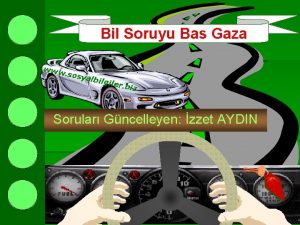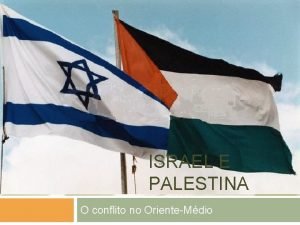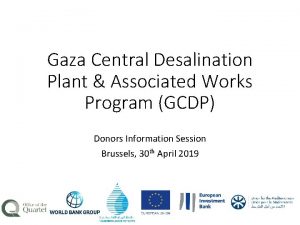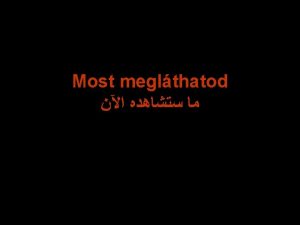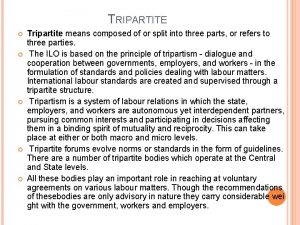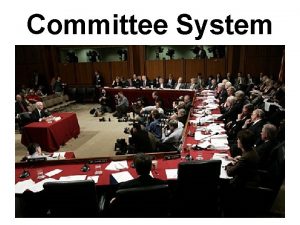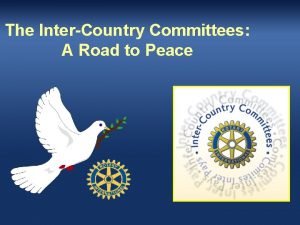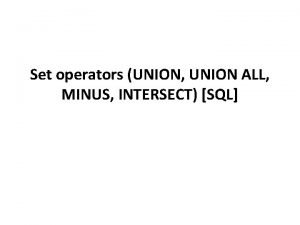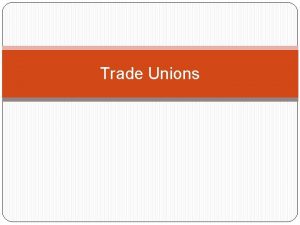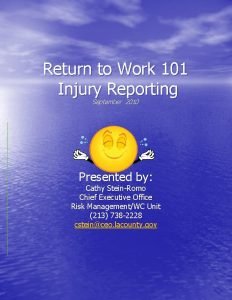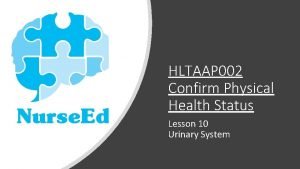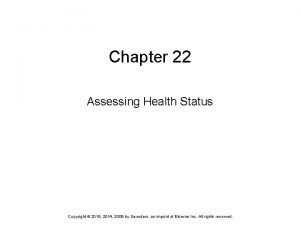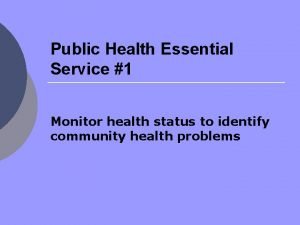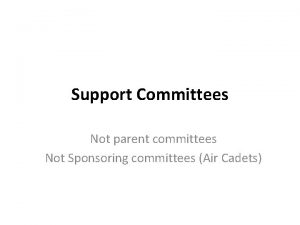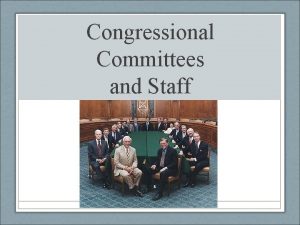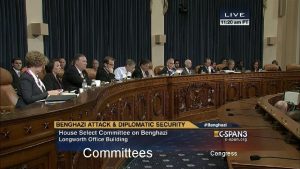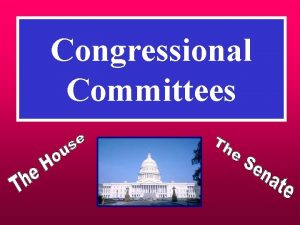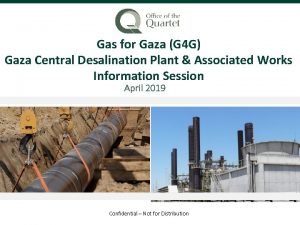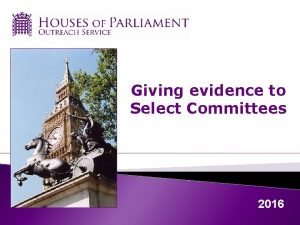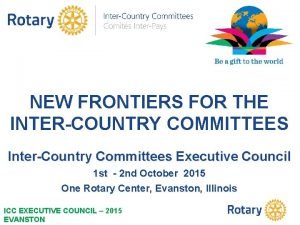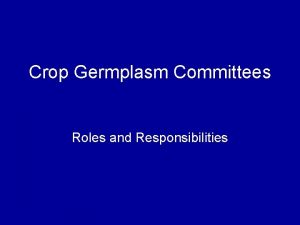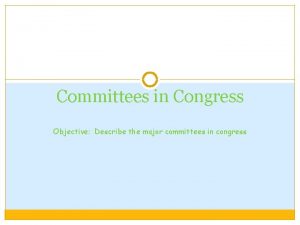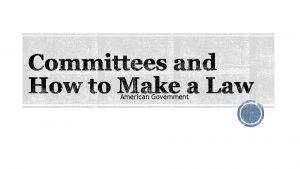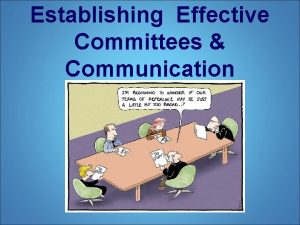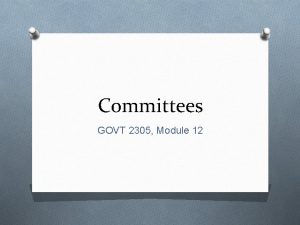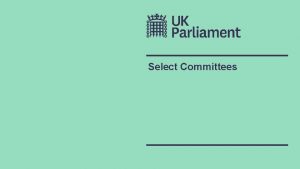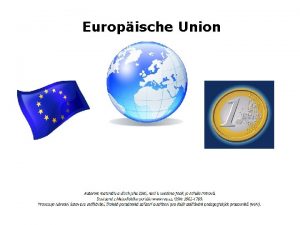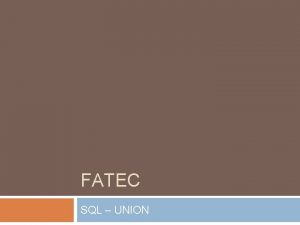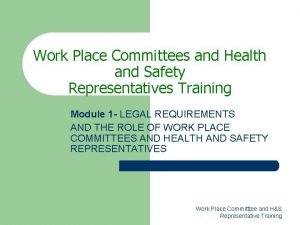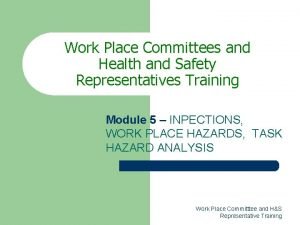Union of Health Work Committees Gaza Health Status


























- Slides: 26

Union of Health Work Committees Gaza Health Status in the Gaza Strip Realities and Challenges December 11 th 2007

Main Points • Selected health and socio-demographic indicators • Change in socio-political context • Impact of current situation on health status • Impact of current situation on health facilities • Challenges and Recommendations

Remember !!! Health Determinants • There are close links between health and socioeconomic and political contextual factors. • Peace, education, employment, social welfare, equity, income, and democracy are well known major determinants of health of any given population. Consideration of these significant factors is extremely important in Gaza, a “highly political and highly vulnerable area”. • Current Problems in Gaza are not new “Acute on Top of Chronic”- Gaza is inherently vulnerable.

Geographical context-relatively Caged Rat Syndrome islarge developing jail full speed now • 360 square kilometers • Only around 2% of historical Palestine (Gaza is a perfectly sealed prison without roof). very high population density (>4500) For high quality UN map go to page 7 of this link

Selected Socio-Demographic Indicators Indicator Total population Under 15 years old Dependency ratio (%) Population increase rate Refugees Unemployment Below poverty line Literacy rates (number of children leaving Figure Around 1. 5 m 50% 1. 07 3. 8% 69% 40 -85% 84% schools is increasing) Post Traumatic Stress Syndrome 61%

Women’s Health Indicators Indicator Total fertility rate Maternal mortality ratio Prevalence of anemia among pregnant women Contraceptive use prevalence rate Ante-Natal Care coverage Post natal coverage Institutionalized deliveries Median age of marriage Figure 5. 8 15. 4 -35 Reach 75% 43 90% 23% 100% 18

Child Health Indicator Figure Immunization coverage Above 95 IMR (per 1000 live birth) Between 20 -25 Stunting 13 -15% Underweight 8% Anemia 40 -50% Among the leading causes of death U 5 Pre maturity, respiratory related diseases, accidents Child labor 4. 2% Neonatal deaths-admitted (increased by 23%)

Disease Burden-Double constraints • Gaza undergoes epidemiological transitions; – Diseases of poverty (resulting from bad sanitation, poor infrastructure, inadequate education, malnutrition and so on). – Diseases associated with stress (heart diseases, diabetes, hypertensions, cancer and so on) Plus – Injuries resulting from the Israeli hostilities and also the internal clashes

Larger Picture • Strategic planning is difficult? ? The only certain thing is uncertainty • Palestinians have little control over their resources and borders • Collective punishment is a common Israeli practice – including electricity cuts, diminished fuel supply • Financial resources largely depend on external aid • Resources are limited and people’s expectations are high • Services are fragmented and poorly coordinated; Ministry of Health regulatory roles are not clear

Political Context • Occupation is still there!! Longest occupation in modern history • Israeli hostilities since the second Intifada – such as incursions – have heavily affected health • Decreased financial assistance to the Palestinians – donors’ agenda • Dramatic change in political context took place after January 2006 elections.

continued • Formation of Hamas-led government in March 2006 • April 2006, suspension of direct payments to Palestinian Authority by the International Communities and the NO contact policy • Establishing new mechanisms, such as “TIM” to channel aid directly to Palestinians and by-passing Hamas Government • Distortion of the programs/systems-sustainability!! • Boycott of most development projects – focus on emergency and relief

continued • In June 2007, Hamas took over the Gaza Strip; resulting in: – Two entities for one people – Two Governments for the same people; one for Gaza and the other for West-Bank – Two Ministers for one Ministry of Health – In many cases, two directors for one organization (Shifa Hospital) – Sanctions and closures became tighter, more aggressive and took new forms – Gaza declared by Israel as “Hostile Entity” – Unprecedented division of Palestinians

Impact on Health System-Management – Dogmatic relationships between the two bodies (Gaza versus Ramallah) – Contradictory Decisions – Reversing decisions (each reverses the decision taken by the other side). – Employees don’t know to whom to report, to whom to listen, to whom to respond, and what to do – Long Strikes –decreasing working hours (restricting surgeries to emergencies) – Violence against employees – using force to implement decisions

continued – Distortion of accountability and the work culture (don’t work – stay at home and take your salary) – Political loyalty replaces productivity – Replacement of original workers by volunteers – Withdrawal of most donors from Gaza Strip – Shift from development to crisis management – Growing disintegration of social fabric and values of Palestinian society – Distortion of vision “Politics not health is what matters the most”

IMPACT OF HEALTH STATUS • Impact will be more visible later – “after effects”. • Strict SIEGE – diminished access to treatment abroad (around 800 patients were denied permissions to leave Gaza). More than 20% of permits are denied. • Over 34 patients died because of the denied access and many are still waiting. Additionally, 30 died at Rafah crossing. • Physical & psychological isolation of population • Increased prevalence of disabled people • Diminished access to health services (financial; access to medicines; availability of skilled providers)

continued • Increased demands for health services; increased poverty related diseases; sanitary related conditions – due to electricity cuts which affect water supply and sewage disposal, solid waste disposal. • Increased number of casualties resulting from both internal clashes as well as Israeli hostilities. • Clients shifts among providers as a result of diminished abilities of health facilities to provide the services they used to provide.

Impact on Health Facilities • Diminished capacity of health facilities to provide services • Closure of certain health facilities (MMS) • Clients shifts and performing unanticipated roles • Responding to increasing demands for health services • Shortages of medications & disposable and medical equipment (more than 20% of ED and 30% of supplies are lacking). 150 items with less than 3 months stock • Zero stock of hospitalized patients’ food

Impact on Health Facilities • Decreased morale and motivation of health personnel • Lack of materials for maintenance, spare parts and infrastructure related activities (e. g. 7 out of 17 pediatric incubators are not functioning) • Suspended maintenance, training & capacity building and development activities • Electricity cuts, lack of fuel, lack of adequate water, movement restriction even within Gaza. • Distortion of the referral system.

Impact on Financing Health Services • Decreased financial assistance to Health facilities in Gaza • Diminished clients’ contributions to Health Service • Clients’ shift to other free of charge providers (UNRWA and some NGOs) • Stopping/reluctance to reimburse the VAT revenue referral to PA by Israel • Suspension of salaries of public sector • Cutting payments for a large number of employees (around 1000 in MOH) • MOH is unable to regularly reimburse NGOs for the purchased health services

continued • Focus on financing emergency response rather than long term development • Lack of raw materials needed for infrastructure – suspension of funds allocated to Infrastructure activities • Change of fundraising environment • Donor fatigue • Emerging of unanticipated problems • Tied aid • Donors political agenda

How We Still Perform? • Increasing preparedness for emergencies • Performing new roles and introducing new services • Increasing coordination with international community, advocacy and lobbying • Activating fundraising as much as possible • Establishing Patients’ support fund • Reducing medical services fees • Recruiting volunteers • Increasing coordination with peer providers • Advocacy and lobbying with community/NGOs • Empowering communities through health education • Credit to some donors who continued their assistance regardless of any other reasons

Current Challenges in General • • • The situation in very serious in Gaza – near collapse Health indicators are deteriorating Risk of emergence of infectious diseases – environmental Diminished access to preventive and curative services for the majority of Palestinians Decline of basic health services towards possible collapse, compromising services availability, accessibility, quality, sustainability and equity Severe financial constraints/crisis Collapse of control and management systems Un-planned clients shifts among providers – ad hoc shift If the current situation continues, all Palestinian Public Health achievements including immunization will be eroded

Recommendations • Gaza should be regarded as an area that requires intense attention – a disaster area • Politicians should respect the rules of the game otherwise there will be no MOH left to control! • Influential health providers should put pressure on politicians to avoid using health as a tool in political games • Palestinian reconciliation is the top priority to end this catastrophic situation • Until that occurs, politics should be kept away from health services as much as possible

Recommendations • Ending the occupation and its associated siege on Gaza is a top priority. • Access to basic health services should be guaranteed regardless of any political conflicts. • Access to basic human services needs to be guaranteed in all circumstances regardless of any other factors such as electricity, water supply, basic sanitation, healthy environment. • Lobbying Campaign for respect of international laws and human rights conventions should be developed. • Balance between emergency support and long term development should be maintained.

Recommendations • Donors should consider contributing to covering the running costs of health organizations at least at the short term to maintain their survival and prevent their possible collapse • Social contexts affecting health should be supported, including education, women’s empowerment, community empowerment, alleviating poverty, providing job opportunities • Efforts should be directed to overcome the chronic health problems in Gaza by conceptualizing health as linked to social and community development and welfare and community empowerment through a multi-sectoral collaboration.

 Health work committees
Health work committees Sınıfı
Sınıfı Pakimires
Pakimires Bil soruyu bas gaza
Bil soruyu bas gaza Gaza strip map
Gaza strip map Gaza strip map
Gaza strip map Mapa franja de gaza
Mapa franja de gaza Palestina e israel mapa
Palestina e israel mapa Gaza central desalination plant
Gaza central desalination plant Dzsenin
Dzsenin There are....tripartite committees at the national level..
There are....tripartite committees at the national level.. Committees of correspondence colonists reaction
Committees of correspondence colonists reaction Examples of select committees
Examples of select committees Explain how standing committees function
Explain how standing committees function Lesson quiz 5-2 the structure of congress
Lesson quiz 5-2 the structure of congress Committees of correspondence
Committees of correspondence Rotary intercountry committees
Rotary intercountry committees Effective safety committees
Effective safety committees Effective safety committees
Effective safety committees Intersect and minus in sql
Intersect and minus in sql Work union meaning
Work union meaning Work status report from doctor
Work status report from doctor Code pink hospital kaiser
Code pink hospital kaiser 002
002 Community health status indicators
Community health status indicators Assessing health status chapter 22
Assessing health status chapter 22 Monitor health status
Monitor health status
